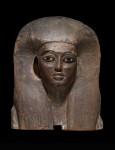 A wood mask that once adorned the head of a mummy from the 18th Dynasty (ca. 1550-1295 B.C.) sold at auction on Thursday for £116,500 ($151,291). A beautifully carved visage with full lips and a small, straight nose features big eyes with stone whites and obsidian pupils. The eyebrows used to be inlaid as well, but the stone is gone leaving only the recess in the wood. Under the chin is a small groove where a false beard was once attached. There are traces of the bitumen used to glue the piece in place still left. The inlay and fine details indicate this was an expensive piece used for a person of high status in New Kingdom society.
A wood mask that once adorned the head of a mummy from the 18th Dynasty (ca. 1550-1295 B.C.) sold at auction on Thursday for £116,500 ($151,291). A beautifully carved visage with full lips and a small, straight nose features big eyes with stone whites and obsidian pupils. The eyebrows used to be inlaid as well, but the stone is gone leaving only the recess in the wood. Under the chin is a small groove where a false beard was once attached. There are traces of the bitumen used to glue the piece in place still left. The inlay and fine details indicate this was an expensive piece used for a person of high status in New Kingdom society.
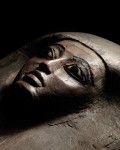 In addition to being a beautiful and rare artifact, the mask has another claim to fame: it was first acquired in Egypt by Lady Jane Franklin, wife of that Sir John Franklin who died with all of his crew on a doomed 1845 expedition to find the Northwest Passage. The discovery of one of his ships, the HMS Erebus, has been the subject of many an entry on this blog.
In addition to being a beautiful and rare artifact, the mask has another claim to fame: it was first acquired in Egypt by Lady Jane Franklin, wife of that Sir John Franklin who died with all of his crew on a doomed 1845 expedition to find the Northwest Passage. The discovery of one of his ships, the HMS Erebus, has been the subject of many an entry on this blog.
Jane Franklin had even more of a traveling jones as her husband, and she voyaged without the support of a navy often in extremely challenging conditions. She was born Jane Griffin in 1791 to family of means. Her father was a wealthy silk weaver of Huguenot extraction. Her mother, also of Huguenot descent, died when Jane was three years old. Jane was educated at a boarding school for elegant young ladies, but it was insufficiently challenging for a girl of her wits and energy. From the age of 17, she fleshed out her education with extensive travel on the continent, accompanied and supported by her family. She did all the stops of the Grand Tour and more, spending years on the road in France, Italy, Switzerland, Germany, Holland and Denmark.
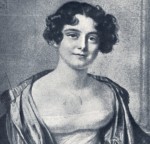 Finding a husband does not appear to have been as high on the priority list for Jane as was customary for women of her class in 19th century England. She had a couple of romances, one with medical student Adolphe Butini, another with Dr. Peter Mark Roget of thesaurus fame, but neither got past the chaste yearning stage and both men married other women. Jane was just shy of 37 years old when she married John Franklin, a remarkably advanced age for a woman’s first marriage in 1828. She was his second wife — his first, poet Eleanor Anne Porden who was a good friend of Jane’s, had died in 1825 — and her new marital status changed her peripatetic ways not a bit. The tone was set when they were still engaged and she caught up with in St. Petersburg to travel around Russia together.
Finding a husband does not appear to have been as high on the priority list for Jane as was customary for women of her class in 19th century England. She had a couple of romances, one with medical student Adolphe Butini, another with Dr. Peter Mark Roget of thesaurus fame, but neither got past the chaste yearning stage and both men married other women. Jane was just shy of 37 years old when she married John Franklin, a remarkably advanced age for a woman’s first marriage in 1828. She was his second wife — his first, poet Eleanor Anne Porden who was a good friend of Jane’s, had died in 1825 — and her new marital status changed her peripatetic ways not a bit. The tone was set when they were still engaged and she caught up with in St. Petersburg to travel around Russia together.
After he got a new assignment captaining the HMS Rainbow in the Mediterranean in 1830, Jane took the opportunity to travel widely whenever he was busy, which was often as the area was mired in tension courtesy of the Greek War of Independence. She went to Greece, Turkey, Syria, Palestine and Egypt, traveling independently and often going off the beaten track. In Egypt she sailed from Cairo up the Nile to the Second Cataract, even engaging in a slightly naughty (for the time) flirtation with a Prussian minister on board.
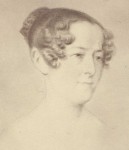 Franklin was called back to London in 1834 while Jane was still traveling in Greece. She kept doing her thing for another year, eventually meeting back up with her husband and joining him in the long voyage down under when he was appointed lieutenant-governor of Van Diemen’s Land (Tasmania) in 1836. Once there, she dedicated her endless energy to founding a museum, a scientific society, acquiring land for a botanical garden, working for prison reform and of course, travel. She was the first European woman to climb Mount Wellington. She took the arduous overland route to Macquarie Harbour along Tasmania’s untamed west coast and traveled from Melbourne to Sydney, likely the first woman to do so.
Franklin was called back to London in 1834 while Jane was still traveling in Greece. She kept doing her thing for another year, eventually meeting back up with her husband and joining him in the long voyage down under when he was appointed lieutenant-governor of Van Diemen’s Land (Tasmania) in 1836. Once there, she dedicated her endless energy to founding a museum, a scientific society, acquiring land for a botanical garden, working for prison reform and of course, travel. She was the first European woman to climb Mount Wellington. She took the arduous overland route to Macquarie Harbour along Tasmania’s untamed west coast and traveled from Melbourne to Sydney, likely the first woman to do so.
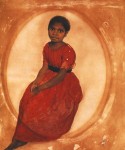 It wasn’t all voyaging good times. Jane took a liking to an Aboriginal girl named Mathinna and adopted her, ie, just took her from her still-living parents who had already had one child stolen by British authorities to blackmail them into resettlement against their will. That daughter was dumped in an orphanage and died. Now their second daughter became Jane Franklin’s black doll. Mathinna was dressed up pretty, went on carriage rides next to Eleanor, John Franklin’s daughter from his first marriage, and was educated by her governess. When John Franklin’s term as lieutenant-governor ended in 1843, the Franklins returned to London leaving Mathinna behind in the same orphanage where her sister had died. Jerked around for her whole life and left unable to fit in anywhere, Mathinna would die at age 17, apparently from drowning in a puddle while drunk.
It wasn’t all voyaging good times. Jane took a liking to an Aboriginal girl named Mathinna and adopted her, ie, just took her from her still-living parents who had already had one child stolen by British authorities to blackmail them into resettlement against their will. That daughter was dumped in an orphanage and died. Now their second daughter became Jane Franklin’s black doll. Mathinna was dressed up pretty, went on carriage rides next to Eleanor, John Franklin’s daughter from his first marriage, and was educated by her governess. When John Franklin’s term as lieutenant-governor ended in 1843, the Franklins returned to London leaving Mathinna behind in the same orphanage where her sister had died. Jerked around for her whole life and left unable to fit in anywhere, Mathinna would die at age 17, apparently from drowning in a puddle while drunk.
The Franklins just went about their business, oblivious to the fate of the little girl they had displaced so callously. Driven in significant part by Jane’s efforts, Sir John Franklin got the chance he had long yearned for to return to the Arctic. This would be his fourth and final expedition. He and a crew of 108 men took HMS Erebus and HMS Terror to Canada in 1845. Arctic Canada would be their graves.
When her husband failed to return in 1847 as planned, Lady Franklin marshalled her considerable resources of finance and dedication to his rescue. In 1848 she offered rewards of $10,000 and $15,000 to anyone who should attempt to bring succor to the missing expedition. In April of 1849, she wrote a letter to the President of the United States, noting that the ships had been provisioned with enough supplies for three years and with four years nearly gone, any survivors would be in extreme need. She hoped to persuade the US to send out rescue ships as the Russian Empire was planning and the British Admiralty had already done.
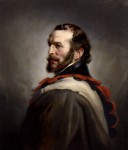 When other missions failed to find traces of the Franklin expedition, Jane outfitted her own. In the 1850s she poured money into five different search missions. Even though by then there was no chance of anyone having survived, in 1854 she redoubled her efforts after Captain John Rae, first sent by the Admiralty and then by the Hudson Bay Company on a rescue mission, returned with artifacts from the Franklin expedition and Inuit testimony of survival cannabilism among the crew. Disgusted and horrified by Rae’s news, she rejected it vehemently as the gossip of savages and became even more motivated to find what was left of the ships and their logs. She was sure they would prove conclusively that her husband, officers and crew had behaved with nothing but the most British of honor to the last.
When other missions failed to find traces of the Franklin expedition, Jane outfitted her own. In the 1850s she poured money into five different search missions. Even though by then there was no chance of anyone having survived, in 1854 she redoubled her efforts after Captain John Rae, first sent by the Admiralty and then by the Hudson Bay Company on a rescue mission, returned with artifacts from the Franklin expedition and Inuit testimony of survival cannabilism among the crew. Disgusted and horrified by Rae’s news, she rejected it vehemently as the gossip of savages and became even more motivated to find what was left of the ships and their logs. She was sure they would prove conclusively that her husband, officers and crew had behaved with nothing but the most British of honor to the last.
 Her last attempt to directly fund a search team was the steam yacht Fox captained by Francis Leopold McClintock in 1857. Ice blocked his path for two years, but finally in 1859 he encountered Inuits who told him of the ships crushed by ice off King William Island and of its crew who subsequently died of starvation. When McClintock reached King William Island, he bought several Franklin expedition artifacts from the Inuit. McClintock’s second-in-command, William Hobson, found an Admiralty form in a cairn at Victory Point on King William Island which had a note scrawled in the margin revealing that Franklin had died on June 11th, 1847. These were the only official records of the expedition ever found.
Her last attempt to directly fund a search team was the steam yacht Fox captained by Francis Leopold McClintock in 1857. Ice blocked his path for two years, but finally in 1859 he encountered Inuits who told him of the ships crushed by ice off King William Island and of its crew who subsequently died of starvation. When McClintock reached King William Island, he bought several Franklin expedition artifacts from the Inuit. McClintock’s second-in-command, William Hobson, found an Admiralty form in a cairn at Victory Point on King William Island which had a note scrawled in the margin revealing that Franklin had died on June 11th, 1847. These were the only official records of the expedition ever found.
Lady Franklin and Captain McClintock were awarded the 1860 patron’s medal from the Royal Geographical Society. She was the first woman to receive the award, and for many decades the only one. It was exceptionally fitting since the missions she had funded ended up discovering and mapping more of the Canadian Arctic than any explorer ever had, including her husband.
 Jane Franklin would outlive Sir John by 30 years, and never stopped traveling the world. She dined with Brigham Young at Salt Lake City, hiked in Yosemite, had an audience with
Jane Franklin would outlive Sir John by 30 years, and never stopped traveling the world. She dined with Brigham Young at Salt Lake City, hiked in Yosemite, had an audience with Pope Pius IX in Rome, stipulating ahead of time that she would not be kneeling, climbed Mount Olympus, became friends with Queen Emma of Hawaii, went on her first trip to India when she was 74 years old and traveled the subcontinent for three years.
Pope Pius IX in Rome, stipulating ahead of time that she would not be kneeling, climbed Mount Olympus, became friends with Queen Emma of Hawaii, went on her first trip to India when she was 74 years old and traveled the subcontinent for three years.
When she died in 1875 at the age of 84, six Arctic explorers were her pallbearers.